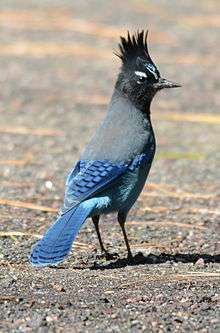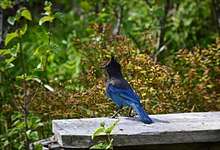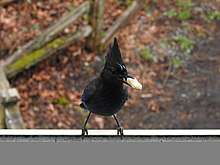Steller's jay
Steller's jay (Cyanocitta stelleri) is a bird native to western North America, closely related to the blue jay found in the rest of the continent, but with a black head and upper body. It is also known as the long-crested jay, mountain jay, and pine jay. It is the only crested jay west of the Rocky Mountains. It is also sometimes colloquially called a "blue jay" in the Pacific Northwest, but is distinct from the blue jay (C. cristata) of eastern North America.
| Steller's jay | |
|---|---|
 | |
| Steller's jay in Flagstaff, Arizona, with white head-markings typical of eastern-variety birds (C. s. macrolopha) | |
| Scientific classification | |
| Kingdom: | Animalia |
| Phylum: | Chordata |
| Class: | Aves |
| Order: | Passeriformes |
| Family: | Corvidae |
| Genus: | Cyanocitta |
| Species: | C. stelleri |
| Binomial name | |
| Cyanocitta stelleri | |
 | |
Description
.jpg)
Steller's jay is about 30–34 cm (12–13 in) long and weighs about 100–140 g (3.5–4.9 oz). Steller's jay shows a great deal of regional variation throughout its range. Blackish-brown-headed birds from the north gradually become bluer-headed farther south.[3] The Steller's jay has a more slender bill and longer legs than the blue jay and has a much more pronounced crest.[4]:69 It is also somewhat larger.
The head is blackish-brown, black, or dark blue, depending on the latitude of the bird, with lighter streaks on the forehead. This dark coloring gives way from the shoulders and lower breast to silvery blue. The primaries and tail are a rich blue with darker barring. Birds in the eastern part of its range along the Great Divide have white markings on the head, especially over the eyes; birds further west have light blue markers and birds in the far west along the Pacific Coast have small, very faint, or no white or light markings at all.
Phylogeny
Steller's jay (Cyanocitta stelleri) is one of two species in the genus Cyanocitta, the other species being the blue jay (Cyanocitta cristata); because the two species sometimes interbreed naturally where their ranges overlap in the eastern foothills of the Rocky Mountains, their status as distinct species has been contested. There are 18 subspecies of Steller's jays ranging from Alaska to Nicaragua, with nine found north of Mexico, often with areas of low or non-existent presence of the species separating the subspecies. At least some of the variation in the species is due to different degrees of hybridization between Steller's jays (C. stelleri) and blue jays (C. cristata) . To name a few:[5]
- C. s. macrolopha (central and southern Rockies)
- C. s. stelleri (Pacific coast from Alaska to southwestern British Columbia)
- C. s. carlottae, the largest subspecies (Queen Charlotte Islands).
The genus Cyanocitta is part of the passerine family Corvidae, which consists of the crows, ravens, rooks, jackdaws, jays, magpies, treepies, choughs, and nutcrackers.
Habitat

Steller's jay occurs in most of the forested areas of western North America as far east as the eastern foothills of the Rocky Mountains from southern Alaska in the north to northern Nicaragua in the south[5] completely replacing the blue jay prevalent on the rest of the continent in those areas. Its density is lower in the central Rocky Mountain region (Montana, Idaho, Wyoming and eastern Utah) plus the desert or scrubland areas of the Great Basin (e.g. Nevada, western Utah, southern Arizona and parts of California). Some hybridization with the blue jay in eastern foothills of the Rocky Mountains, especially Colorado, has been reported. It is also found in Mexico occurring through the interior highlands in northwestern Mexico as well as patchy populations in the rest of Mexico.
Steller's jay is also found in Mexico's interior highlands from Chihuahua and Sonora in the northwest southward to Jalisco, as well as other patchy populations found throughout Mexico. It is also found in south-central Guatemala, northern El Salvador, Honduras and Nicaragua.[3]
Although Steller's jay primarily lives in coniferous forests, it can be found in other types of forests as well. They can be found from low to moderate elevations, and on rare occasions to as high as the tree line. Steller's jays are common in residential and agricultural areas with nearby forests.[6]
Diet

Steller's jays are omnivores; their diet is about two-thirds plant matter and one-third animal matter. They gather food both from the ground and from trees. Steller's jay's diet includes a wide range of seeds, nuts, berries and other fruit. They also eat many types of invertebrates, small rodents, eggs, and nestlings such as those of the marbled murrelet. There are some accounts of them eating small reptiles, both snakes and lizards.[6]
Acorns and conifer seeds are staples during the non-breeding season; these are often cached in the ground or in trees for later consumption. They exploit human-provided food sources, frequently scavenging picnics and campsites, where it competes with the Canada jay.
Steller's jays will visit feeders and prefer black-oil sunflower seeds, white striped sunflower seeds, cracked corn, shelled raw peanuts, and are especially attracted to whole raw peanuts. Suet is also consumed but mostly in the winter season.
Breeding
Steller's jays breed in monogamous pairs.[7] The clutch is usually incubated entirely by the female for about 16 days.[8] The male feeds the female during this time. Though they are known to be loud both day and night, during nesting they are quiet in order to not attract attention.[9]
The nest is usually in a conifer, but is sometimes built in a hollow in a tree. Similar in construction to the blue jay's nest, it tends to be a bit larger (25 to 43 cm (9.8 to 16.9 in)), using a number of natural materials or scavenged trash, often mixed with mud. Between two and six eggs are laid during breeding season. The eggs are oval in shape with a somewhat glossy surface. The background colour of the egg shell tends to be pale variations of greenish-blue with brown- or olive-coloured speckles.
Vocalizations
Like other jays, the Steller's jay has numerous and variable vocalizations. One common call is a harsh SHACK-Sheck-sheck-sheck-sheck-sheck series; another skreeka! skreeka! call sounds almost exactly like an old-fashioned pump handle; yet another is a soft, breathy hoodle hoodle whistle. Its alarm call is a harsh, nasal wah. Some calls are sex-specific: females produce a rattling sound, while males make a high-pitched gleep gleep.
The Steller's jay is also a noted mimic: it can imitate the vocalizations of many species of birds, other animals, and sounds of non-animal origin. It often will imitate the calls from birds of prey such as the red-tailed hawk, red-shouldered hawk, and osprey, causing other birds to seek cover and flee feeding areas.[5][6]
Etymology
This bird is named after the German naturalist Georg Wilhelm Steller, the first European to record them, in 1741.[10][11] Johann Friedrich Gmelin formally named the species after Steller in the 13th edition of Systema Naturae (first published in 1788).
Provincial bird
The Steller's jay is the provincial bird of the Canadian province of British Columbia.[12]
References
- BirdLife International (2012). "Cyanocitta stelleri". IUCN Red List of Threatened Species. 2012. Retrieved 26 November 2013.CS1 maint: ref=harv (link)
- "Cyanocitta stelleri". Integrated Taxonomic Information System. Retrieved 2019-08-13.
- Walker, L. E.; Pyle, P.; Patten, M. A.; Green, E.; Davison, W.; Muehter, V. R. (2016). Rodewald, P. G. (ed.). "Steller's Jay (Cyanocitta stelleri)". The Birds of North America Online. Ithaca, New York: Cornell Lab of Ornithology. doi:10.2173/bna.343. Retrieved 2019-08-13.
- Madge, S.; Burn, H. (1994). Crows and Jays: A Guide to the Crows, Jays and Magpies of the World. Boston, MA: Houghton Mifflin.
- "Steller's Jay Cyanocitta stelleri". National Geographic. Retrieved 6 June 2013.
- "Steller's Jay". Seattle Audubon Society. Retrieved 6 June 2013.
- Gabriel, P. O.; Black, J. M. (July 2012). "Reproduction in Steller's Jays (Cyanocitta stelleri): individual characteristics and behavioral strategies". The Auk. 129 (3): 377–386. doi:10.1525/auk.2012.11234. JSTOR 10.1525/auk.2012.11234.
- Tweit, R. C. (2005). "Steller's Jay". Texas Breeding Bird Atlas. Texas A&M. Retrieved 6 June 2013.
- Kaufman, K. "Steller's Jay". Audubon Society. Retrieved 2019-08-13.
- "Steller's Jay". Cornell Laboratory of Ornithology. The Birds of North America Online. Cornell University. 2013. Retrieved 6 June 2013.
- Evans, Howard Ensign (1986). Halpern, Daniel (ed.). Antæus on Nature. London, UK: Collins Harvill. p. 24.
- "B.C. Symbols - Province of British Columbia". gov.bc.ca. Government of British Columbia. Retrieved 2019-08-13.
Further reading
- Goodwin, D. (1976). Crows of the World. Seattle, WA: University of Washington Press.
- Greene, E.; Davison, W.; Davison, W.; Muehter, V.R. (1998). "Steller's jay - Cyanocitta stelleri". The Birds of North America. No. 343.
External links
| Wikispecies has information related to Cyanocitta stelleri |
- "Steller's jay". Cornell Laboratory of Ornithology. Species Account. Cornell University.
- "Steller's jay media". Internet Bird Collection.
- Steller's jay photo gallery at VIREO (Drexel University)
| Wikimedia Commons has media related to Steller's jay. |
